R.O. Hodgell: master linocutter
Introduction
A bee in my print collector’s bonnet arrived last October when I couldn’t help myself but poke about in Key West’s few antique/collectible shops. In one was a large striking relief print obviously a takeoff on Dürer’s Adam and Eve. Instead of a snake providing the forbidden fruit it was a small long-necked dinosaur. Other prehistoric critters patrolled the forest. The artist, Robert O.Hodgell (1922-2000), was completely unknown to me. Even with 35 years’ print collecting experience, finding a “new” American printmaker is not so unexpected. Yet my collector’s eye told me: The guy had wit and talent. I wanted to know more.
R.O. Hodgell, Eden Revised, linocut,19.5″ x 29.5″, ed. 75 All images are courtesy of the Estate of R.O. Hodgell.
Naturally, I googled the name and found a website devoted to a whole Hodgell family: R.O. Hodgell, his wife Lois P. Hodgell, and his daughter Patricia C. Hodgell. Most of the website (http://www.pchodgell.com/site/index.php?module=htmlpages&func=display&pid=4) was devoted to R.O. His printmaking, all relief prints ( I thought woodcuts), was particularly prodigious and fascinating. So R.O.Hodgell was now on my radar. And the radar beeped when Lifeboat appeared on eBay.
Lifeboat, linocut, 23 1/2″ x 15 1/2″, ed. 75
No need for fancy interpretations: The fat, self-satisfied float in boats, while the sea is a whirlpool of bodies reaching up, trying to climb aboard. Printmaking with passion. It was a “make an offer” eBay auction. I did, and it was soon mine. Now the fun begins. I wanted to know more about the print. My version has two names in pencil: “R.O. Hodgell” at the lower right bottom and “P.C. Hodgell 2004” written around the corner and up the right side.
So I turned to the website and sent a message to P.C. Her father died in 2000. So I was pretty sure she signed his name. Her response confirmed it. “If you saw one with both of our names on it, odds are he left it unsigned and I signed for him, as instructed by a gallery,” she said. “Was his ‘signature’ more or less in block letters? If so, that was me, identifying the artist but trying not to pass myself off as him.”
Her response motivated me to propose sending her a series of questions so I could compose a blog post about her father. She readily agreed. But my first questions were not about her father, but about her. Why did she put together this website? Why indeed, since in the initial email she indicated how little she knew about him: “But I can only guess when the blocks were cut or printed. Dad left no records. My parents divorced when I was two. I was brought up by a grandmother, so I didn’t see much of either of them or know what they were working on at any given time. He was a wonderful artist, though, wasn’t he?”
This Art I See post will also include comments from Arthur Skinner and David Gliem, two art professors at Eckerd College in St. Petersburg, FL, where R.O. taught from 1962 (when Eckerd was called Florida Presbyterian College) until 1977. (The college became Eckerd in 1972.)
Two Hodgell linocuts on Old Testament themes: The Burning Bush, 21″ x 11″ (left), and Job (right). Note: Patricia has supplied me with sizes only for the prints she has in her possession.
About Patricia Hodgell
Unlike her visual artist parents, P.C. is a writer. It’s best for me to refer you to her own introduction to her craft at: http://www.pchodgell.com/site/index.php?module=htmlpages&func=display&pid=1 Here is our conversation about her:
I understand that you are principally a writer. Could you briefly describe the running themes of your books, how many there have been, and the audience you are writing to?
Six Kencyrath novels are in print and a seventh is due out next month. The first one, God Stalk, was first published as Young Adult, but that was an accident. I write the sort of material that I like to read–intricate, sometimes dark, sometimes funny. It’s all fantasy. Thirty-plus years ago I started telling the story of Jamethiel (aka Jame) Priest’s bane and I’m still at it.
Themes. Hmm. A major one would be people trying to come to grips with gods/the divine. I’m an agnostic, but I find questions of faith and reality fascinating. Jame is also trying to identify herself within the context of her people and their history. She is becoming the third face of their much despised god, That-Which-Destroys, which is rough on her because she really wants to protect her friends and family. Honor is another theme, specifically Honor’s Paradox: Is honor a personal thing or does it depend on obeying orders?
You said previously that once your parents divorced you were raised by a grandparent. Yet your website is largely devoted to keeping the art of your parents alive. What was the relationship you had with your parents, particularly as an adult? How did their creative efforts influence or motivate you? Why did you start the website?
I started the web-site in 2000 after my father’s sudden death from undiagnosed colon cancer. It seemed unthinkable that so much talent and creativity could simply end, but he did leave a house full of art behind, so I focused on that. Then it seemed unfair not to also celebrate my mother’s work, although she was more a teacher than an artist, so I collected as many slides of it as I could, most of work belonging to her friends.
A Hodgell self-portrait in watercolor.>
As an artist myself, I’m largely self-taught. Besides having a natural affinity for stories, I think my parents’ creativity rather intimidated me. The last art class I took in college was taught by my father. It didn’t go well. As for my relationships with my parents in general, we got along, but we never really talked. At the time, that seemed natural. Now I’m sorry for it. An odd thing happened, though, when my first novel came out. Suddenly my father started writing me eloquent letters full of detail. It was as if he’d finally realized that we had something in common, i.e. creativity.
While I was in Florida at his death bed, my mother back in Wisconsin started making me increasingly bizarre phone calls. By the time I got home, she had descended into complete dementia–the result, I think, of a series of silent strokes suffered while I was gone. Whereas before we had lived in companionable silence, now she wouldn’t leave me alone. It drove me half crazy. I cared for her at home for several years before moving her to assisted living where she eventually died. The whole process was a terrible thing to watch.
Are you (I’m not sure what the proper word is) the keeper of your parents’ artist estate? Do the images on the website represent objects in your possession? If so how, why and when did they end up with you?
I suppose I’m my parents’ artistic executor now, at least for the works that I have in my possession, and also for the copyright to Dad’s images, especially the prints. When he died, his house was stuffed with art work. I don’t think he ever threw anything away. I donated two-thirds of it to Eckerd College and brought the rest–at least 1,500 pieces–home. Most of the pieces on the website are in my possession, except for the ceramics and any painting with an asterisk in its title. Those I’ve either sold or only have a slide of them.
Another Old Testament themed linocut, but this time Hodgell presents Abraham Sacrificing Isaac, 19.5″ x 26″, in contemporary anti-war clothes.
Patricia on R.O.
Then I asked her a second set of questions on her handling of the estate and her knowledge of her father’s printmaking.
What of your dad’s artwork did you decide to give to Eckerd and what did you keep? Did Eckerd get a complete set of his prints?
It’s hard to remember. Basically, I took everything that I liked, and I like his watercolors best. I also took most of his acrylic figure paintings and landscapes. And I seem to have ended up with a lot of naked ladies. I don’t think he left a complete set of his prints, although Eckerd may have them anyway. I’ve collected most of them, all but about ten.
From your previous answer, an image of a print on your website indicates you have at least one copy of it. Right?
Yes, with about four exceptions.
Hodgell definitely had some strong opinions about the use of words as weapons, especially in academic venues: Flood, 24″ x 15″ (left), and Colleagues, 25″ x 18″ (right).
At the same time you suggest that, other than Lifeboat and Eden Revised, he didn’t edition prints?
According to my records, these are his limited editions, although he didn’t indicate what number each print is, so it’s hard to say how many he actually printed:
Lifeboat (75 ed), Eden Revised (75 ed), Cage (50 ed?), Connie (50 ed), Dawn (75 ed), Descent (50 ed), Elephants (75 ed), Footwashing (75 ed), I to Eye (75 ed), Jazz Quartet (75 ed), Macho Cho Cho (75 ed), Making Face (50 ed), Mary Washes His Feet (50 ed), Miss America (50 ed), Myakka Jazz (75 ed), Oh Susanna (50 ed), Owed to a Grecian Urn (50 ed), Poet (75 ed), Poor Old Lazarus (75 ed), Preservation Jazz ( 75 ed), Reunion (75 ed), Sacrifice (75 ed), Seashell Seller (20 ed), Sleepers (10 ed), Sue and Sasha (30 ed), This Time It’s Apples (75 ed), Through the Night (25 ed), Transit (75 ed), Two Gators (50 ed), and Yellow Dog Jazz Band (30 ed).
All the others are unlimited editions, and there’s no way to know how many copies he printed over the years. He tried to keep a bit ahead of demand, so he left a pile of various mostly unsigned prints. I suppose about half the prints I have are signed.
Tiger, 17″ x 26″ (left), and Elephants, 18″ x 26.5″ (right)
What are your favorite prints of his and why?
Eden Revised, for its detail and sly humor. Colleagues, The Professor and Academic Pursuit, because I was in academia for years. Daniel among the Lions: humor and composition. Tiger. Elephants.
Did your dad save his woodblocks? Did they go to Eckerd or did you keep them?
There are some woodblocks, but most of his prints are Battleship lino. Eckerd has a few. I have the rest.
How good was he in storing his finished work, and what was the condition of the work at the time of his death?
His house was on the Bradenton River in Florida, so conditions were pretty humid. Many of the remaining prints are foxed. The other artwork is in pretty good condition.
What about his record-keeping of what he made and where sold work went?
Mostly, he kept track of what art shows he was in. I found no records of sales.
Has your website led to any renewed interest or exhibitions of R.O.’s work? If so, what?
People have been glad to see the range of his work, and I’ve sold a few pieces because of the site. A gallery in Chicago took some early work on commission and bought some pieces themselves. On the whole, though, not much has happened. The biggest recent excitement was caused by the rediscovery of an enormous (400 foot long, 28 feet high) series of murals that he painted for the 1948 Centennial Fair depicting 100 years of Wisconsin agriculture. The Wisconsin Historical Society had them restored and has been showing them, two at a time, at recent fairs. (A search of “Hodgell” on the Wisconsin Magazine of History website brings this result: http://www.wisconsinhistory.org/Content.aspx?dsNav=Ntk:All%7chodgell%7c3%7c,Ny:True,Ro:0&dsNavOnly=N:1176&dsDimensionSearch=D:hodgell,Dxm:All,Dxp:3&dsCompoundDimensionSearch=D:hodgell,Dxm:All,Dxp:3&fromsearch=true)
Two more biblical images: Golgotha, 15″ x 24″ (left), and The Prodigal, 18″ x 27″ (right).
Woman, 17″ x 25″ (left) and Female Sleeper, 20″ x 27″ (right).
Arthur Skinner
Eckerd College Professor of Visual Art
Patricia Hodgell suggested I contact two professors at Eckerd College. I did, and both kindly fleshed out this essay on R.O. Hodgell. Arthur Skinner gave a first-person account of modelling for a Hodgell linocut, while David Gliem describes why he has spent three or four years on an article about Hodgell. First here’s Arthur’s account:
I did have the great privilege of watching Hodgell do a demo for my class once maybe 30 years ago or so. (His prints are linocuts, by the way, not woodcuts [at the time I contacted him I was assuming incorrectly that his prints were woodcuts] ; he used Armstrong Battleship linoleum, that he bought in rolls). He sat across the table and did a quick portrait of me, first drawing the image directly on the block (I can’t recall with what tool he drew), and then cutting with remarkable speed. He used only one tool, a shallow gouge. With the gouge in his right hand, sliding along at a various angles, he’d then make a quick move left with his hand to break the surface (as opposed to “plowing” as some people do with gouges). The linoleum literally flew off the block, some bits hitting me in the face while I sat still for the portrait. He printed by hand (always), and for the print he demonstrated, he inked with a small brayer, rubbed the back of the print paper (I can’t recall what sort of baren [burnisher] he used, but it may have even been his hand. Then he’d gently lift half the print paper up, re-ink, lay back down, and rub further. Then he’d lift the other half, re-ink, lay back down, and rub further. Done. He always used a sepia ink. While cutting he had a remarkable ability to preserve the spontaneity of the initial drawn line. Unfortunately I don’t have the block or the print that he made that day, nor will you find it in his extensive inventory of prints.
After Skinner reviewed a draft of this post, he sent me this account of a Hodgell “lecture”:
Bob was most effective in teaching by example. Since he was an artist for whom making art daily was a vital necessity, simply being in his presence was an inspiration.
In our general education program he would annually give a “lecture” to the freshman class titled “Hodgell Paints.” And for the entire lecture hour he would say not a word, but would stand on stage with an easel upon which was placed a sheet of masonite about 2’ x 3′ (a great many of his paintings are on masonite), and with a clothed model selected from the audience and seated on a stool on stage with him, he would very energetically paint a completed portrait. Students in the auditorium never would have witnessed anything like it before–an intense performance of the creative process.
We have Hodgell shows from time to time. Our most recent was in the fall of 2012: Hodgell in an Election Year [the poster for which is shown above]. The year before that we had an exhibition of some of his figure paintings (of which we possess quite a few). And we have tentative plans to feature another Hodgell show in the coming academic year, of some of his religious imagery in linocut.
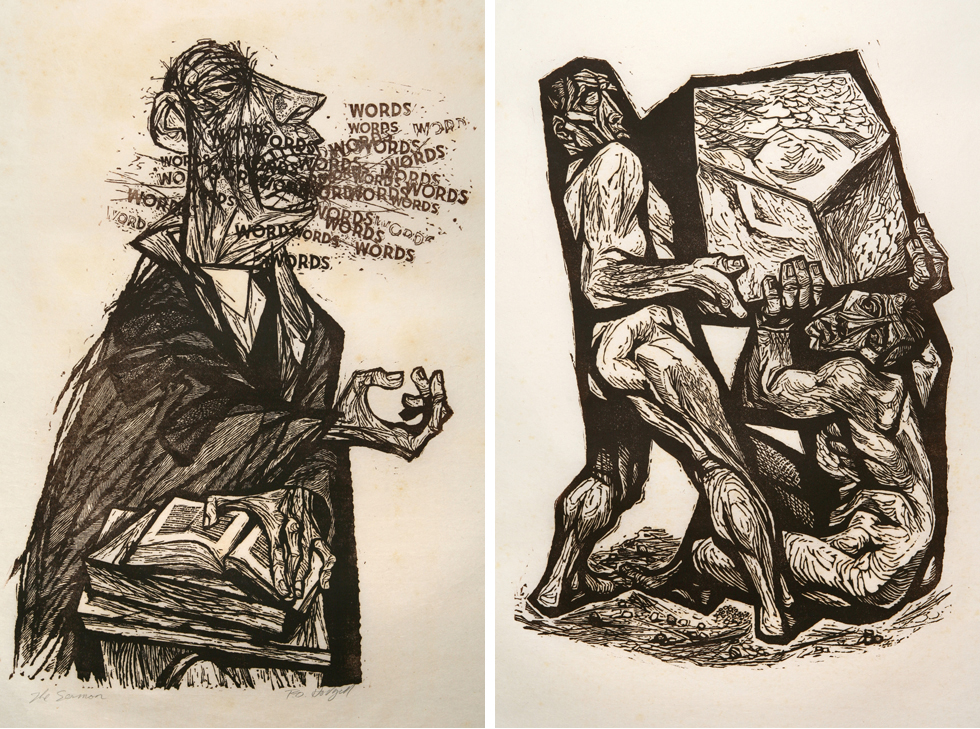
Sermon, 21″ x 15″ (left) and Help, 19″ x 13″ (right)
Consensus, 20″ x 13.5″ (left), and Lonely Ones, 31″ x 22″ (right).
David Gliem
Eckerd College Assistant Professor of Art History and Chair of the Creative Arts Collegium (Fall 2014)
To my surprise, David had this comment when I first emailed him about writing a blog post on R.O.: “One of my projects is finishing an article on Hodgell that I’ve been working on off and on over the last 3 or 4 years. He was an immense talent in a variety of media.” In another email he wrote: “I’ve been surrounded by his work for nine years here at Eckerd. Ever since I first encountered his art during my interview, I knew I had to write about him.” So emailing David proved to be a fortuitous connection. Here are his responses to my questions:
What was is about Hodgell’s artwork that would have you conclude: “I knew I had to write about him”?
Hodgell’s work is everywhere on campus, and we have lots more in storage. I have a half dozen or so objects in my office including paintings, linoleum cuts, and ceramic sculptures. I first saw his paintings during my interview in the main administration building: one large-scale painting of a tangle of mangrove trees rendered in bright colors and fluid brushwork; another was a Midwest scene, a farm yard probably from Kansas where he grew up. A number of his Midwestern scenes, largely of the countryside, can be found on campus. The latter painting had a much different character from the former in that it was much tighter, the brushwork was more controlled and the line was crisp and well-defined. He was trained as a painter by John Steuart Curry, the famed regionalist painter, muralist and printmaker; so much of his aesthetic is derived the great muralist tradition of the early 20th century. He also loved to paint the figure, especially the female nude. Regionalists also loved figures. I have one of those in my office, and a couple more hang outside in the hallway. Music was another passion. He made a few very large prints of jazz concerts. One of these is hanging over the copier in my office. It is thought to be based on a Dave Brubeck concert given on campus in the 1960s or 70s. It looks like Dave sitting at the piano.
I had to write about Hodgell because the quality of the work was so apparent. I also love Regionalist art, Thomas Hart Benton being a favorite, and printmaking. The content of Hodgell’s work is also very thought-provoking. He was instrumental in rethinking and reimagining religious art during the 20th-century (he earned early notoriety/fame for a highly masculinized portrait of Jesus that was different from the more popular effeminate images of Jesus), and he believed in the ability of art to bring about social change and awareness.
Why do you describe his prints as extraordinary? Which are your favorites and why?
One of the reasons, I think, he was so interested in printmaking was it’s accessibility. He never limited his prints to editions and never charged very much for a print. Prints also translated well into print publications. He illustrated many books, and his prints appeared in numerous magazines, including Playboy. I have too many favorites among his prints to mention, though the ones from the 1960s and 1970s concerned with civil rights and the politics from that era are particularly good. Of course, his religious prints are especially well-known. He did a large series of black-and-white linoleum cuts based on the Passion of Christ that hangs in the college chapel.
I like his prints especially because of their energy and expressiveness. His prints are also larger than typical. I think the prints needed to be big because his compositions are so dynamic and his marks are so gestural. Trained as a muralist painter from the time he was a teenager, no doubt working large was just part of his methodology.
In what ways has your appreciation of him and his artwork changed as you’ve worked on an article about him over “the last 3 or 4 years”?
The more I learned about Hodgell and dug more deeply into the ideas embedded in his work the more I grew to appreciate his work. His art is visually enticing but also profound in its content. He was an astute observer of society. His satire cut to the core of social issues.
He was an artist first and foremost. Everyone who knew him remarks about how dedicated he was to making art. He made art everyday. In fact, he left teaching to pursue his art full time. He set up a studio and opened a gallery in Sarasota, FL.
In another email he wrote:
As you might be aware, not much has been written about Bob. Here are two publications you might find useful:
- Richard D. Colvin, “Beyond the Woodcut in Florida” (Rollins College: Cornell Fine Arts Museum, 1997). This has a short bibliography and a brief artist statement by Hodgell.
- Norman Kent, “Religious Relief Prints Created by Robert Hodgell & Robert McGovern,” American Artist 25:4 (April 1961): 38-43, 70-72.
This is the only known journal article about Hodgell that I’ve run across. You’ll find it interesting because it includes some discussion of his process and style.
In his own words
David mentioned the Norman Kent article. In her website Patricia quoted from the interview Kent had with R.O. Here’s a screen shot from her website:
And a few additional linocuts by R.O. Hodgell. Instead of rhapsodizing about what attracts me to his prints, let them sing for themselves.
This time it’s Apples, 24.5″ x 16″ (left), and The Music Tree [Myakka Jazz], 22″ x 15″
Printmaker, 16″ x 13″
Reach, 28″ x 13″ (left,) and Petition, 17″ x 14″ (right). PLEASE SEE ADDENDUN ON REACH
(Clockwise from top left) Daniel among the Lions; He is risen, 15″ x 24″; Luther, 31″ x 22″; Academic Pursuit, 13″ x 25″; Owed to a Grecian Urn, 20″ x 25.5″; and In Silence, 23″ x 21″
ADDENDUM
On 28 Oct. 2017 I received the following comment to this post from Janet Sherwood. The author kindly agreed to share it with ART I SEE readers:
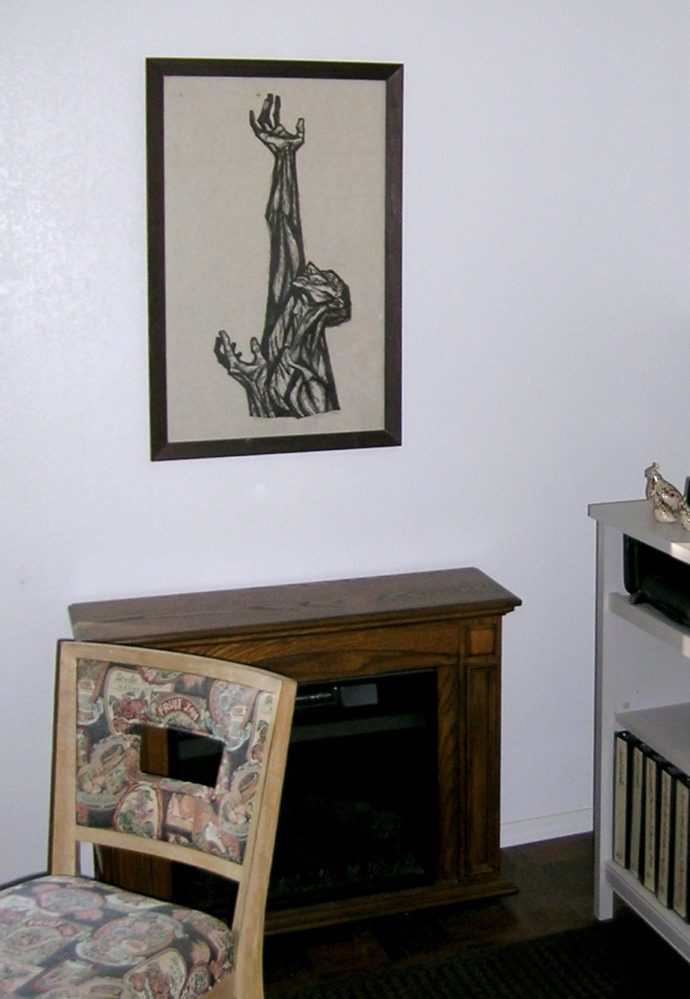
Photo by Janet Sherwood
I was a student at Southwestern University in Georgetown, TX, in the spring semester of 1971. Mr. Hodgell came to our campus that semester.
I was privileged to attend a workshop where he demonstrated, created really, a linoleum block print, before our very eyes exactly as described by Arthur Skinner. He made some of his prints available for us to purchase.
That day, I bought Reach. It has hung in my home (I married that coming summer) all of my married life except for the years my husband made off with it for his insurance office.
Now, in retirement, it hangs in our living room.
The powerful statement never gets old as even our grandchildren are now growing up with it. Thank you for your research and article.
(The other artist I remember from that semester who work was displayed on campus was Alexander Calder. Their influence on me continues to this day.)
Trackback URL: https://www.scottponemone.com/r-o-hodgell-master-linocutter/trackback/

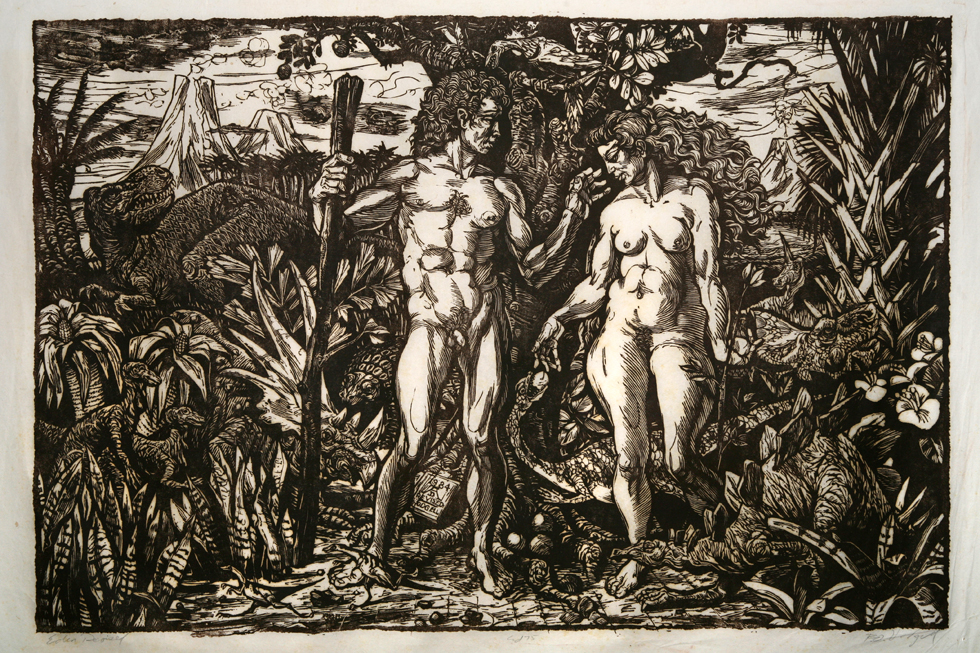
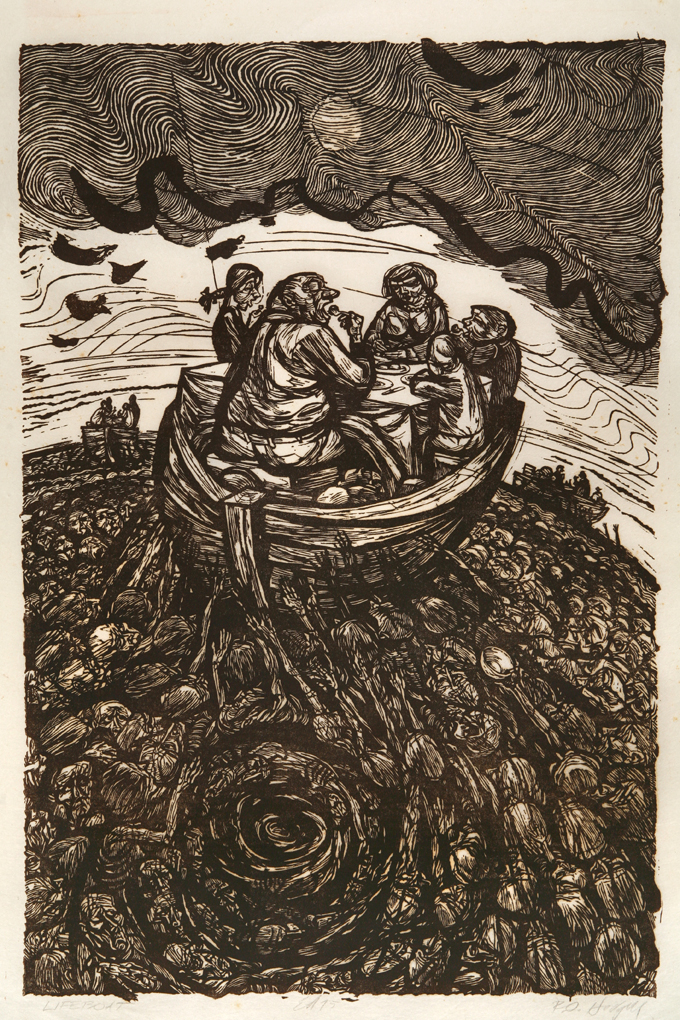
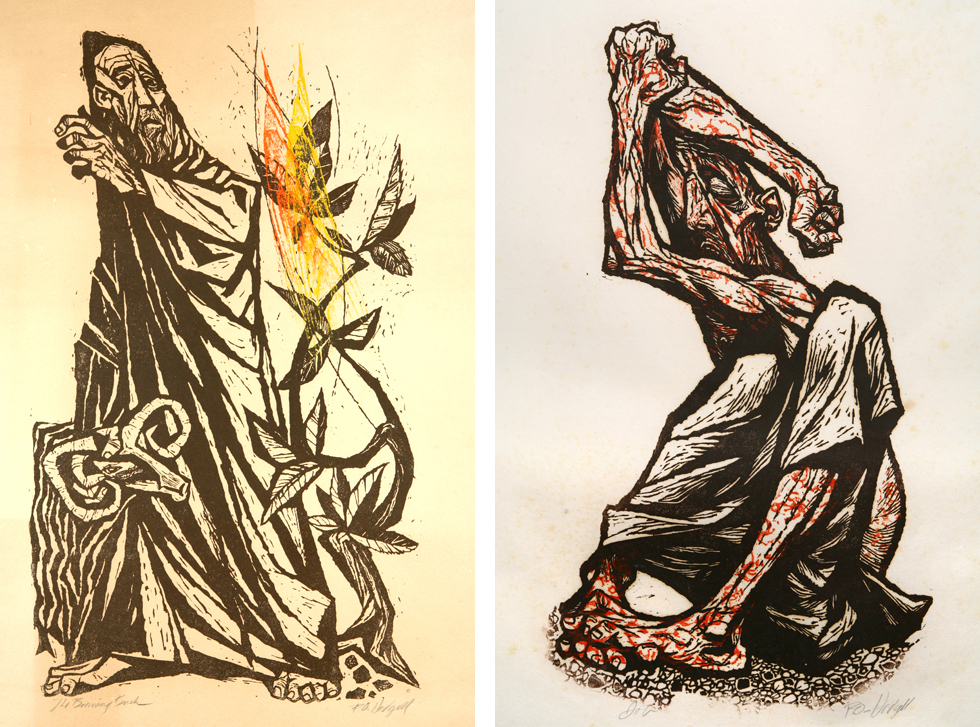
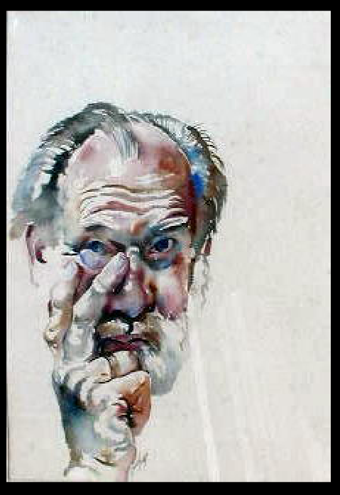
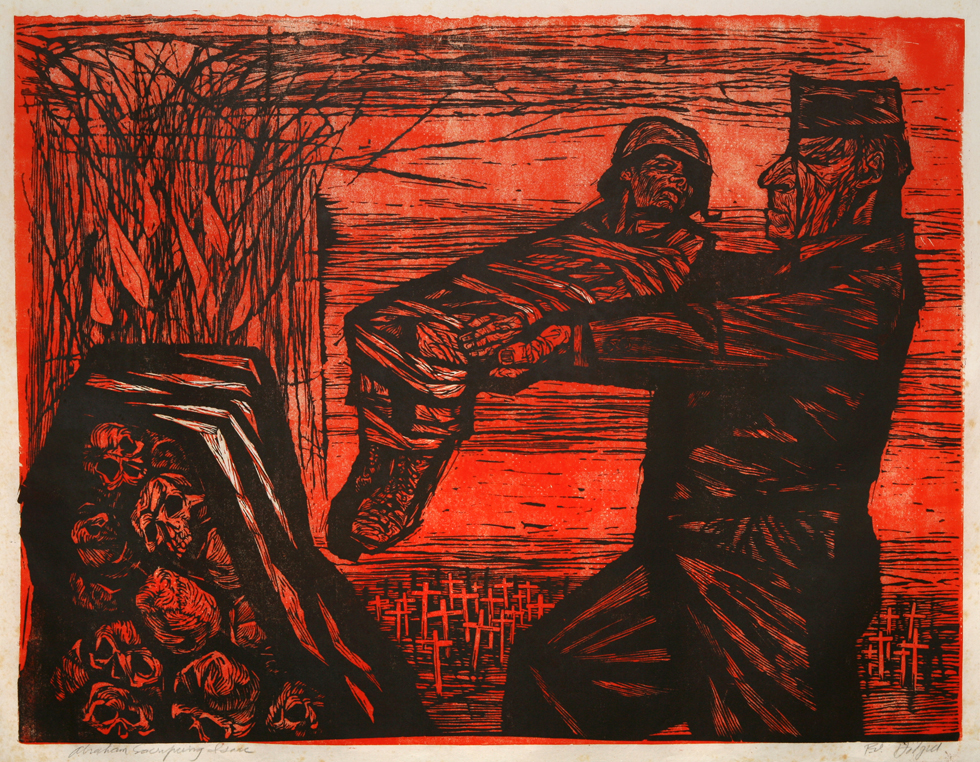
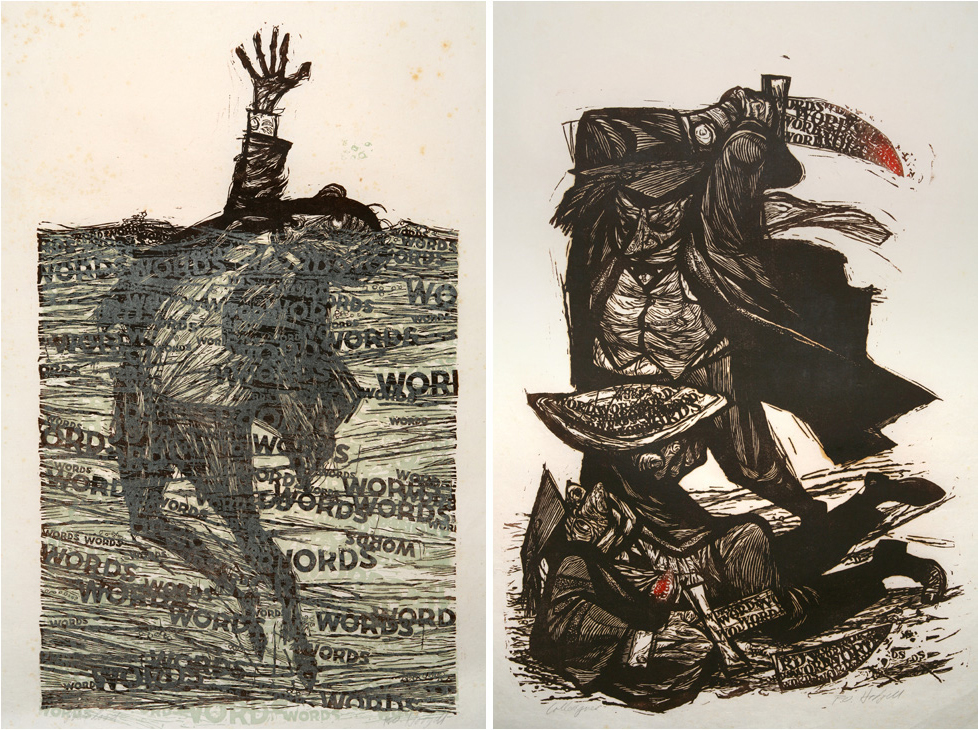



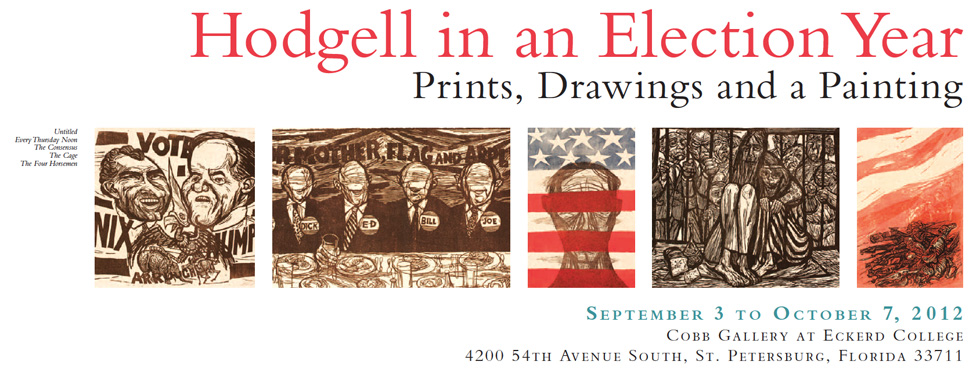
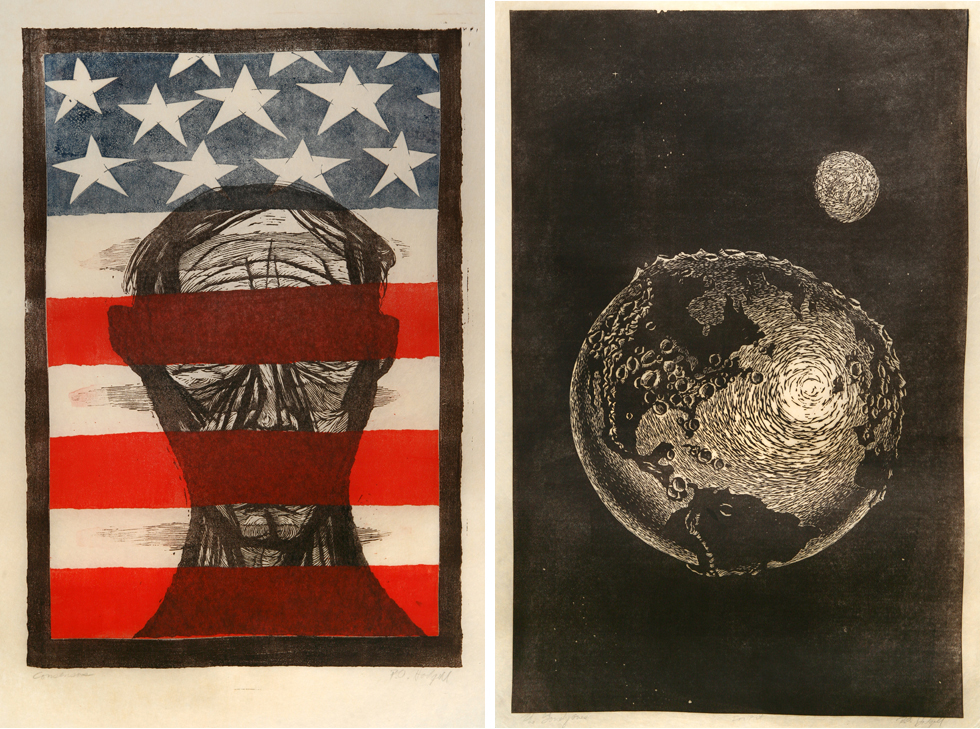
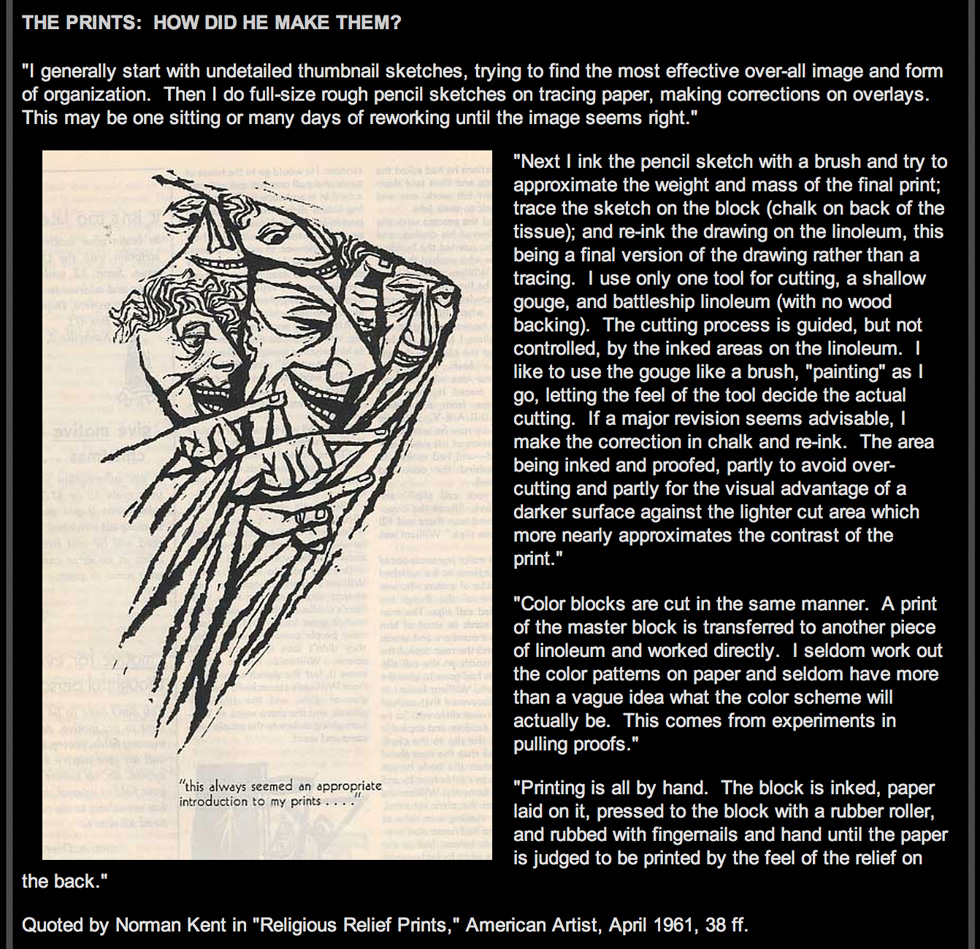
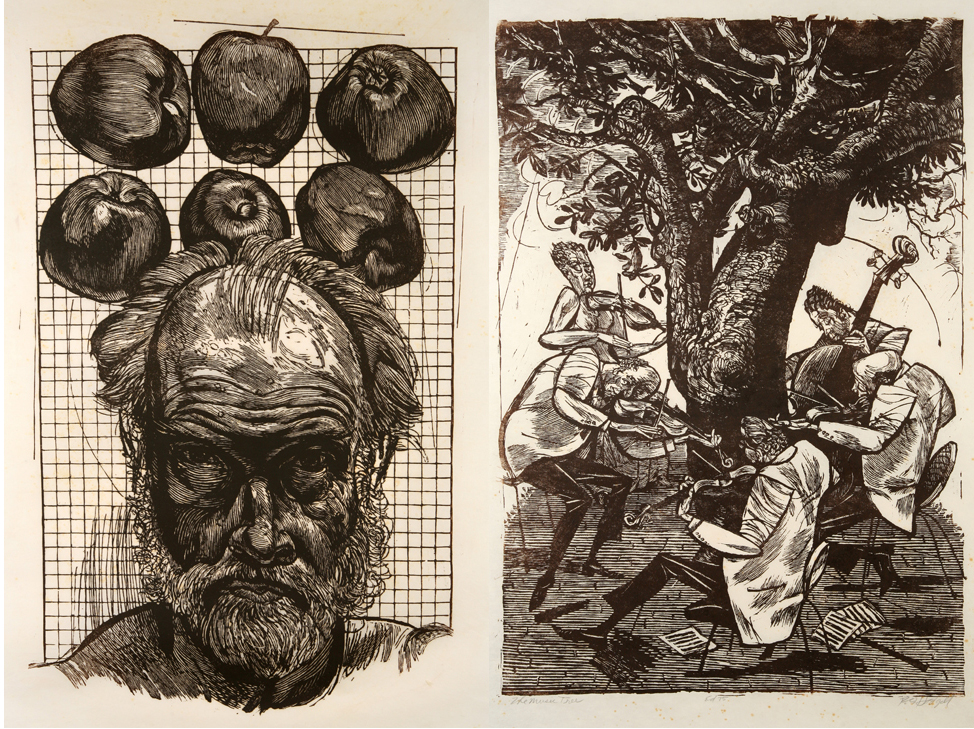
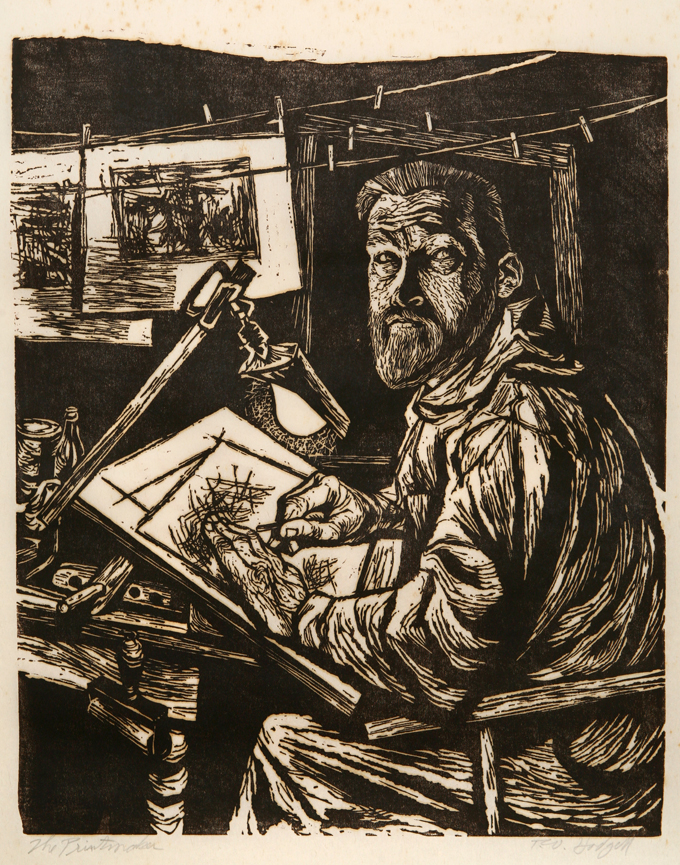
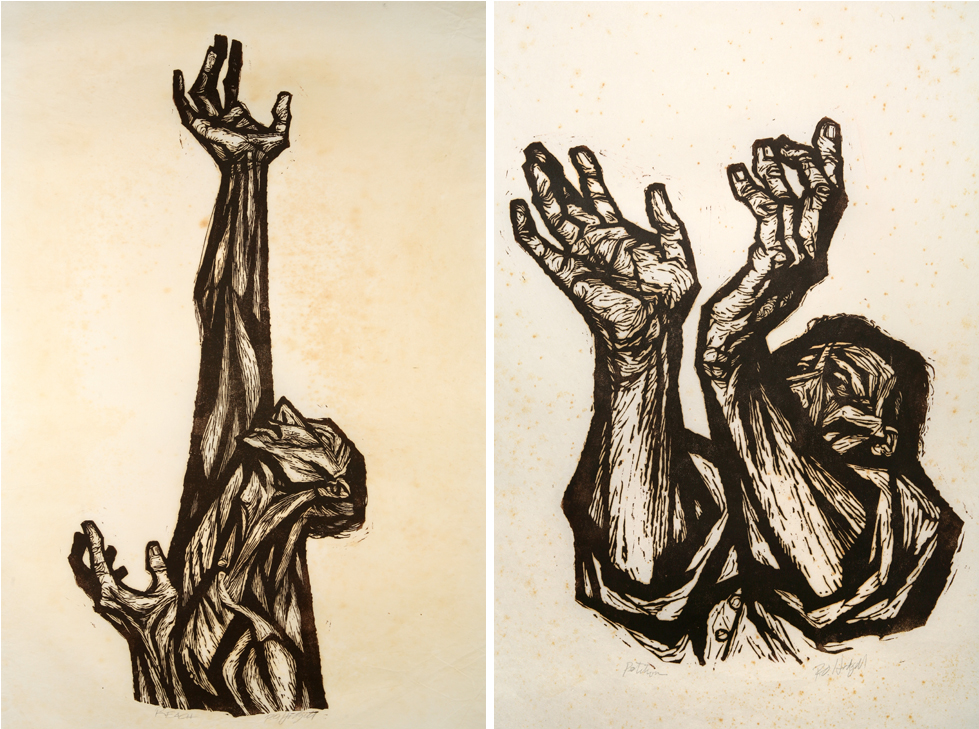
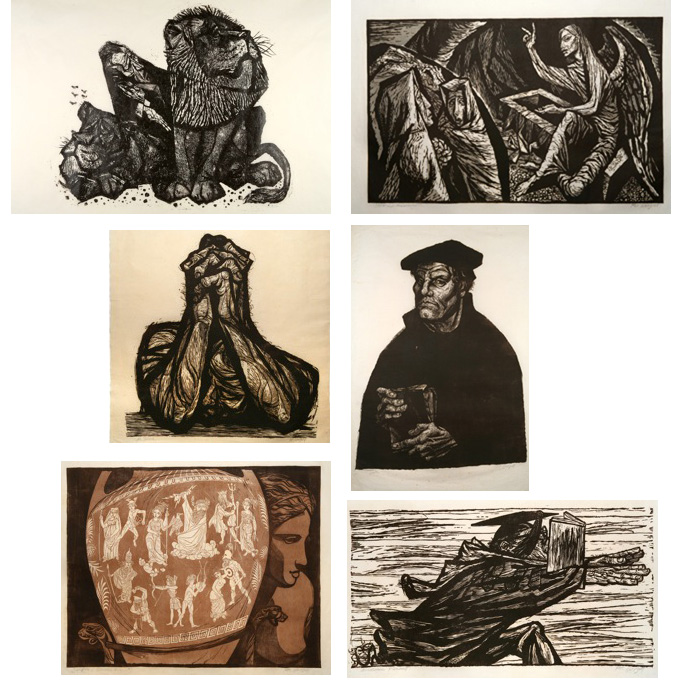










Caught your blog while researching a recent Goodwill purchase, ‘Jury of His Peers’. Like you I immediately found his artwork very striking and very well done. From reading your article I believe it’s a linocut with watercolor or acrylic and we don’t the quantity of the edition. Again a good piece of art.
Oh, read your article on floor coverings in MD and was impressed with the craftsmanship and the finished product was very beautiful. Well done!
David
Thank you for a great blog. I purchased linocut religious print ” peace unto you” at an estate sale yesterday
I found it visually striking and remarkable work
your article is a great read with a human connection to Mr. Hodgell and his daughter Patrcia
With much appreciation and best of success to you.
Perry
Dear Scott – Just purchased an R.O Hodgell linocut titled “The Chasm” depicting provocative civil rights clash. Your excellent essay has enlightened our minds not only with content, but descriptions of process and the delicate human touch within Hodgell’s family. Thank you so much. We will cherish this work even more now. Your astute interviews are a welcome relief.
Joel and Helene
I was a student at Eckerd College while Hodgell was there–late 60’s. Had no real contact other than to see him about campus and hear a little of this and that. I do remember another professor referring to his need to DO art instead of talking about it. Both of these profs felt very much the same in that regard.
Was fortunate to purchase a few prints that Hodgell offered to students at ridiculous prices, as in $1 or so. The Sermon is a favorite because the figure depicted was one of my thesis advisers and a long time inspiration and pain in the ass. Another treasure is a figure of Christ splayed in the print that was obviously part o a series which used the figure in various ways. It is extremely movingl and my favorite depiction of the crucifixion.
We students were indeed fortunate to experience this extraordinary man’s work.
Tom,
So nice to read your comments on R.O.Hodgell. Were you in any of his classes? If so, which ones and how was he as a instructor?
Evidently you can look back at your agreeing to purchase a few of his linocuts as some of your best decisions during your Eckerd years.
Yours, Scott
I was an art major at Eckerd College (1969-1973), and Bob Hodgell and Jim Crane were my mentors. I loved them both hugely and they were fun yet tough. As your poster above remarks, Bob Hodgell would have a students sale once a year but his prints were going for a little more than $4! More like $25 which was astonishingly cheap but still, for a student in the ’60s it hurt a little. We were always taught that art should hurt a bit. Anyway, I have two prints,one I bought and one my friend bought for me as a gift. The one I bought was one I don’t see photos of anywhere, but it’s a rhino with a bird on its butt. The other one is presented in your article here and titled,”Colleagues,” of two scholars fighting with swords made of WORDS.
I love both of these to death, but I am ill and if I were to pass away (:”if”),I am virtually certain that my brother, lovely man that he is, would understand their value. He’s something of a cretin about “arty” things. I don’t want these to end up in a garage sale, or worse still,,a landfill. I don’t believe they are signed but might be under the mat edge. Are these sellable?
BTW, I really enjoyed your article and it took me back to when I knew Bob Hodgell.
Aloha,
Tin
I have what looks like a linocut it has a R.O. Hodgell signature not block letters; “the old one” is also on pint. Writing appears to be pencil. 23 x 15″. Excellent condition not faded. Depicts a large turtle.
Thanks for your note. On the website by his daughter, is written:
Old One
The turtle doesn’t think he’s slow
(He very seldom thinks, you know);
He walked from here to Mexico
Shouting Charge! and Westward Ho!
See: http://www.pchodgell.com/site/index.php?module=PhotoGallery&func=detail&pid=198&startnum=15
Daniel Among the Lions has hung on the walls of my parentts’ home for as long as I can remember. It’s nice to have some information about the artist.
The nicest part of blogging is knowing that I can provide some answers for fellow art owners. Thanks for your note.
I recently acquired a signed print entitled ” In my opinion.” Signature in cursive R O Hodgell. I fiell in love with it and consider it a perfect expression of contemporary political monologues. What can you tell me about it. Thanks.
Dear Mr. Ponemone,
I was a student at Southwestern University in Georgetown, Texas, in the Spring Semester of 1971. Mr. Hodgell came to our campus that semester.
I was privileged to attend a workshop where he demonstrated, created really, a linoleum block print, before our very eyes exactly as described by Arthur Skinner. He made some of his prints available for us to purchase.
That day, I bought “Reach.” It has hung in my home (I married that coming summer) all of my married life except for the the years my husband made off with it for his insurance office.
Now, in retirement, It hangs in our living room today.
The powerful statement never gets old as even our grandchildren are now growing up with it. Thank you for your research and article.
(The other artist I remember from that semester who work was displayed on campus was Alexander Calder. Theirs was an influence on me that continues.))
I graduated from Florida Presbyterian College / Eckerd College in 1970. Never took an art class, but remember Robert Hodgell very well. Always admired his artwork. There is one particular lino that sticks out in my mind. It is a nude man and woman facing each other on their knees in a passionate embrace. Their arms are hanging downward with hands clasped together. I believe they are kissing. Don’t remember the title, but probably something like “Lovers”, or “Man and Woman”. It was one of those linos that Prof Hodgell sold at his yearly sale. A friend in my dorm bought it. I didn’t have the money, even though it was cheap. Have looked through all his linos online without success.